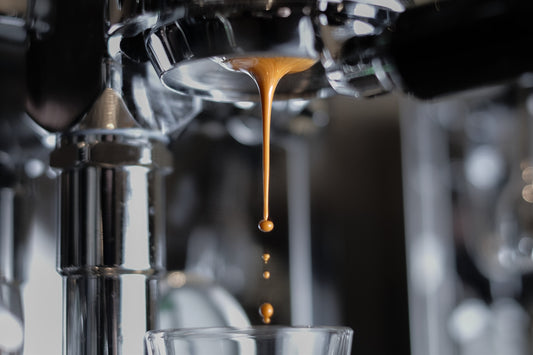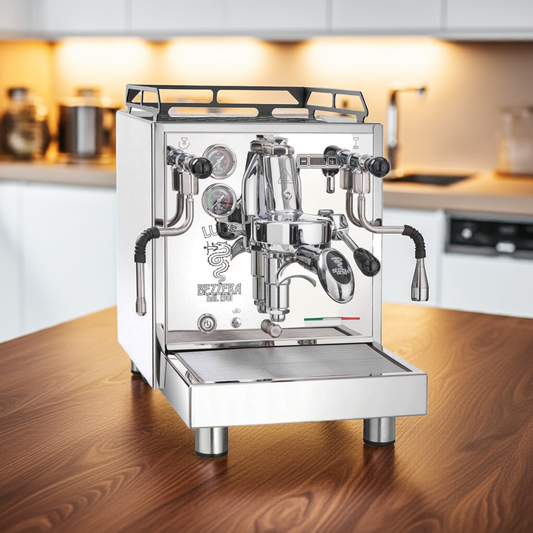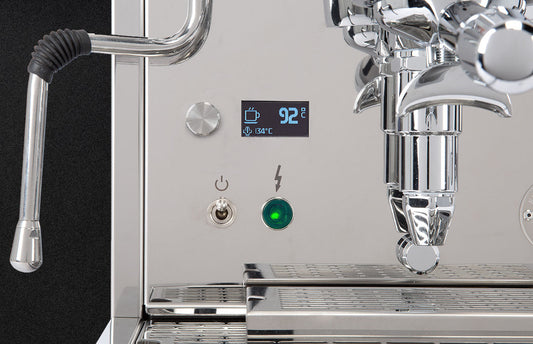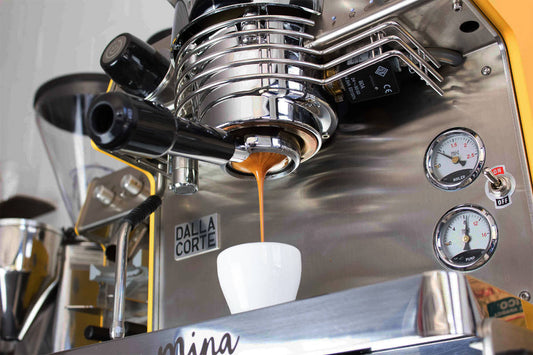Portafilter machines are very robust and built to last for decades. To ensure the machine can reach a great age, it is important that only soft water with a German hardness of 2°-4° is used. With appropriately soft water, only minimal deposits form, which only need to be removed in a major maintenance routine after several years of operation. This saves time, money, and stress.
How limescale and deposits become noticeable
Deposits inside the machine can cause problems in many different places. Because limescale swells in moisture, it can literally push through seals and screw connections, causing leaks. The steam and hot water taps and their seals are particularly affected. The heaviest deposits form on the heating element; due to the large temperature differences and the resulting tension, large pieces of limescale break off over time and collect in the boiler. If these fragments enter the machine's circuit, they can clog valves or affect the water circulation, resulting in less water coming out of the brewing group and the brewing group not heating up properly.
A good indicator for potential descaling is the trumpet in the brewing group. To inspect the pressure trumpet, loosen the larger of the two hex nuts counterclockwise using a 36mm wrench. If the trumpet contains deposits similar to those seen above, the situation in the boiler is certainly no better. Descaling is urgently needed.
Check water hardness
To avoid the problem of deposits from the outset, it's a good idea to consider the water hardness before purchasing a machine. A rough overview of water hardness in various regions of Germany can be found here . More detailed information is available from your local water supplier. If in doubt, small test strips from a pharmacy or aquarium supply store can help.
Treating water: 3 options
If the water isn't perfect, the question arises: what to do? Depending on the water hardness and the machine's pump, there are various ways to reduce the hardness. The most convenient option is a fixed water connection with an intermediate filter cartridge. The performance can be adjusted on the filter head, after which the machine can be operated worry-free for a year before the cartridge needs to be replaced. A rotary pump is required for connection to the water mains. For machines that operate with a storage tank, there are three other options for water treatment.
The first option is a countertop water filter, which is already found in many kitchens. A countertop water filter can prepare water with a maximum hardness of 8° to 9° for espresso machines. One problem, particularly with inexpensive replacement cartridges, is that the pH value doesn't remain stable, and even a perfectly adjusted espresso tastes sour.
The second option for reducing water hardness is to place small pads in the storage tank, which reduce the hardness through an osmotic process. This process takes several hours, so it's best to fill the tank in the evening to ensure you have plenty of filtered water available the next day.
The third option is to fill the machine with bottled water. But be careful, not all bottled water is created equal. Especially at discount stores, there are different sources under the same brand, so the hardness of the same brand varies regionally. A table with many values can be found here .
In general, if in doubt, go with Volvic. The composition is almost ideal, and the values are consistent across regions.
How often should you descale your water? Water hardness in the debate
The correct water hardness is always the subject of extensive debate. This is due to two different perfect hardness levels, one for taste (approx. 7°-8° dH) and the other for the machine's technology (3°-4° dH). However, at 7°-8° dH, the machine needs to be descaled more frequently.
For proper descaling, the boiler and all inlets and outlets must be disassembled and immersed in descaler. All parts must then be rinsed thoroughly with water. This is the only way to ensure that all the descaler is removed from the system and that no dissolved limescale particles settle in pipes and valves and clog them. We strongly advise against continuous descaling for machines with boilers. For water with a hardness of 3-4° dH, it is sufficient to do the machine during maintenance, which is necessary after a few years anyway. The differences in taste are of course subjective, but in my personal opinion, so minimal that I am happy to accept them for worry-free operation.
Conclusion on water hardness for portafilter machines
In summary, water is a key consideration when purchasing a portafilter espresso machine. It's a good idea to find out about the actual water hardness in your area beforehand. Most water suppliers provide the necessary information easily accessible on their websites. Depending on your specific situation and espresso machine, you'll need to decide which system to use. If in doubt, we'll be happy to advise you on the best solution.
Soft water saves a lot of time and money.





